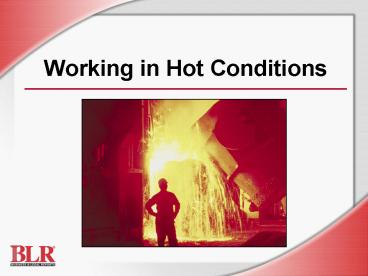Working in Hot Conditions - PowerPoint PPT Presentation
1 / 26
Title:
Working in Hot Conditions
Description:
Understand how hot conditions affect. your body. Recognize symptoms of heat illness ... Why working in hot conditions can be hazardous to your health and safety ... – PowerPoint PPT presentation
Number of Views:283
Avg rating:3.0/5.0
Title: Working in Hot Conditions
1
Working in Hot Conditions
2
Session Objectives
- You will be able to
- Understand how hot conditions affect your body
- Recognize symptoms of heat illness
- Take precautions to reduce the risk of heat
illness
3
What You Need to Know
- Why working in hot conditions can be hazardous to
your health and safety - Types of heat-related illness
- Measures to prevent heat stress on the job
4
Bodys Cooling System
- Blood circulates closer to the skin so heat is
lost - Body sends sweat to the skins surface
- Sweat evaporates off the skin, cooling the body
5
The Heat Equation
- High Temperature
- High Humidity
- Physical Work
- Heat Illness
6
Additional Heat Stress Factors
- Radiant heat
- Air velocity
7
Personal Sensitivity To Heat
- Acclimatization (getting used to heat)
- Age
- Physical condition and overall health
- Metabolism
- Use of alcohol
8
Heat Rash
- Hot, humid environments where sweat cant
evaporate - Red, bumpy rash that often itches
- Uncomfortable, making sleep difficult
- Treatment and prevention
- Rest in a cool place
- Keep your skin dry and clean
9
Fainting (Heat Syncope)
- Worker not used to hot environment
- Worker stands still in heat
- Blood pools in the legs, so less blood goes to
the brain - Quick recovery after lying down in cool place
- Prevent by moving around a little rather than
standing still all the time
10
Heat Cramps
- Painful muscle cramps
- Caused by loss of salt when sweating
- Treated/prevented by drinking electrolyte liquids
- Severe cases require intravenous saline solutions
11
Heat Exhaustion
- Loss of fluids and salt
- Feeling weak, dizzy, or nauseous
- Skin is clammy and complexion is pale or flushed
- Treatment
- Rest in cool place
- Drink electrolyte solution
- Severe cases victims vomit or lose consciousness
12
Heatstroke
- Victim stops sweating
- Symptoms include hot, dry skin
- Confusion, convulsions, or loss of consciousness
may follow - Call for an ambulance immediately
- Keep victim cool and provide fluids if conscious
13
Heat-Related Illness
- Do you understand the information presented in
the previous slides?
14
Heat Can Cause Accidents
- Decreased strength, increased fatigue
- Reduced comprehension and ability to retain
information - Safety procedures not followed
- Other risks
15
Engineering Controls
- General ventilation
- Spot cooling
16
Engineering Controls (cont.)
- Shielding from radiant heat sources
- Substituting machinery for manual labor
17
Administrative Controls
- Schedule heavy work for a cooler time of year or
in the evening and early morning - Allow more frequent breaks or longer rest periods
- Allow time for workers to become conditioned to
heat
18
Administrative Controls (cont.)
- Reduce physical demand on workers
- Use relief workers
- Limit hours on hot work environments
- Pace the work
19
PPE
- Shade-providing hats
- Portable water products
- Reflective clothing
- Systems that circulate air around the body
20
Medical Surveillance
- Periodic medical evaluation
- Determining risk of heat-related illness
- Removing high-risk employees from hot working
environments
21
Work Monitoring Programs
- Check heart rate at the beginning of a rest
period - Check pulse 2.5 minutes after break starts
22
Work MonitoringPrograms (cont.)
- Take oral temperature at end of workday
- Check for body water loss
23
Investigating Heat-Related Illness
- Events leading up to the incident
- Work being done at time of incident
- Length of time employee working
- Engineering and administrative controls
- PPE
- Medical surveillance and worker monitoring
24
Preventing Heat-Related Illness
- Do you understand the information presented in
the previous slides?
25
Water, Water, Water
- Drink plenty of water all day
- Drink electrolyte-balanced fluids if you sweat a
lot - Drink at least one cup of fluid every 15-20
minutes when working in hot conditions - Avoid caffeine and alcohol
26
Key Points to Remember
- Working in hot conditions can affect your health
and safety - Understand the risks and the precautions
- Know symptoms of heat-related illness and
first-aid response - Use all available measures to reduce heat stress
and keep safe and healthy when working in hot
conditions































